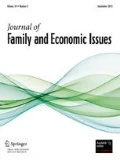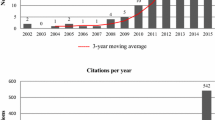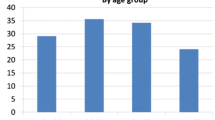Abstract
Using data collected by the National Financial Capability Study, a survey recently commissioned by the Financial Industry Regulatory Authority, this paper investigates the correlations between subjectively and objectively assessed measures of financial knowledge, and the probability of having savings adequate to cover 3 months of typical expenses. Results indicate that households who are more financially knowledgeable or more confident in their financial ability are significantly more likely to report having emergency funds. These findings support the growing literature on the relationship between financial knowledge and economic behaviors and have wide policy implications.
Similar content being viewed by others
Notes
Low saving rates are a distinct characteristic of the US society relative to other developed economies. Some authors (e.g., Garon 2011) attribute this to the US 20th-century culture of mass consumption and reliance on credit.
All dollar signs denote US currency.
The NFCS interviewed a total number of 28,146 respondents, out of which 668 (2.37 %) replied “Don’t know” and 379 (1.35 %) replied “Prefer not to say” to the emergency savings questions.
The differences in means/percentages between the group of respondents who reported having emergency savings and the group of respondents who reported not having emergency savings were statistically significant at the 0.05 level for all variables included in the analysis.
Collins and O’Rourke (2010) provide a comprehensive synthesis of literature that evaluates the effects of financial education programs.
References
Babiarz, P., Widdows, R., & Yilmazer, T. (2012). Borrowing to cope with adverse health events: Liquidity constraints, insurance coverage, and unsecured debt. Health Economics early view,. doi:10.1002/hec.2877.
Bayer, P. J., Bernheim, B. D., & Scholz, J. K. (2009). The effects of financial education in the workplace: Evidence from a survey of employers. Economic Inquiry, 47(4), 605–624. doi:10.1111/j.1465-7295.2008.00156.x.
Bell, C., Gorin, D., & Hogarth, J. M. (2009). Does financial education affect soldiers’ financial behaviors? Presented at the 2009 Federal Reserve System Community Affairs Research Conference, April 16–17, 2009.
Brobeck, S. (2008a). Understanding the emergency savings needs of low- and moderate-income households: A survey-based analysis of impacts, causes, and remedies. Washington: Consumer Federation of America.
Brobeck, S. (2008b). The essential role of banks and credit unions in facilitating lower-income household saving for emergencies. Washington: Consumer Federation of America.
Browning, M., & Lusardi, A. (1996). Household saving: Micro theories and micro facts. Journal of Economic Literature, 34(4), 1797–1855. http://www.jstor.org/stable/2729595.
Bureau of Economic Analysis (BEA). (2012). Personal saving rate. Retrieved August 5, 2012 from http://research.stlouisfed.org/fred2/data/PSAVERT.txt.
Caner, A., & Wolff, E. (2004). Asset poverty in the United States, 1984–1999: Evidence from the Panel Study of Income Dynamics. Review of Income and Wealth, 50(4), 493–518. doi:10.1111/j.0034-6586.2004.00137.x.
Carroll, C. D., & Samwick, A. A. (1996). How important is precautionary saving? Review of Economics and Statistics, 80, 410–419. doi:10.1162/003465398557645.
Carroll, C. D., & Samwick, A. A. (1997). The nature of precautionary wealth. Journal of Monetary Economics, 40, 41–71. doi:10.1016/S0304-3932(97)00036-6.
Chase, S., Gjertson, L., & Collins, J. M. (2011). Coming up with cash in a pinch: Emergency savings and its alternatives. Center for Financial Security. Madison: University of Wisconsin.
Collins, M. J., & O’Rourke, C. M. (2010). Financial education and counseling—still holding promise. Journal of Consumer Affairs, 44(3), 483–498. doi:10.1111/j.1745-6606.2010.01179.x.
Dardanoni, V. (1991). Precautionary savings under income uncertainty: A cross sectional analysis. Applied Economics, 23, 153–160. doi:10.1080/00036849108841059.
Deaton, A. (1992). Understanding Consumption. New York: Oxford University Press.
Fisher, P. J. (2010). Black–white differences in saving behaviors. Financial Services Review, 19(1), 1–16.
Fisher, P. J. (2013). Is there loss aversion in saving behaviors in Spain? Journal of Family and Economic Issues, 34(1), 41–51. doi:10.1007/s10834-012-9290-7.
Fisher, P. J., & Hsu, C. (2012). Differences in household saving between non-Hispanic white and Hispanic households. Hispanic Journal of Behavioral Sciences, 34(1), 137–159. doi:10.1177/0739986311428891.
Fisher, P. J., & Montalto, C. P. (2011). Loss aversion and saving behavior: Evidence from the 2007 U.S. Survey of Consumer Finances. Journal of Family and Economic Issues, 32(1), 4–14. doi:10.1007/s10834-010-9196-1.
Francis, D. (2012). How the savings rate could hobble the economic recovery. U. S. News and World Report. Retrieved March 19, 2013 from http://money.usnews.com/money/business-economy/articles/2012/01/06/how-the-savings-rate-could-hobble-the-economic-recovery.
Garon, S. (2011). Beyond our means: Why America spends while the world saves. Princeton NJ: Princeton University Press.
Guiso, L., Jappelli, T., & Terlizzese, D. (1992). Earning uncertainty and precautionary saving. Journal of Monetary Economics, 30, 307–337. doi:10.1016/0304-3932(92)90064-9.
Haynes-Bordas, R., Kiss, D. E., & Yilmazer, T. (2008). Effectiveness of financial education on financial management behavior and account usage: Evidence from a ‘second chance’ program. Journal of Family and Economic Issues, 29(3), 362–390. doi:10.1007/s10834-008-9115-x.
Hilgert, M. A., Hogarth, J. M., & Beverly, S. G. (2003). Household financial management: The connection between knowledge and behavior. Federal Reserve Bulletin, 89, 309–322.
Hong, G.-S., & Kao, Y. E. (1997). Emergency fund adequacy of Asian Americans. Journal of Family and Economic Issues, 18(2), 127–145. doi:10.1023/A:1024920106444.
Hubbard, G. R., Skinner, J., & Zeldes, S. P. (1994). The importance of precautionary motives in explaining individual and aggregate saving. Carnegie-Rochester Conference Series on Public Policy, 40(June), 59–125. doi:10.1016/0167-2231(94)90004-3.
Hubbard, G. R., Skinner, J., & Zeldes, S. P. (1995). Precautionary saving and social insurance. Journal of Political Economy, 103(2), 360–399. http://www.jstor.org/stable/2138644.
Jones, D. G. (2010). Personal savings rate: Worse than we thought. Fortune. Retrieved September 5, 2012 from http://money.cnn.com/2010/06/30/news/economy/personal_savings_decline.fortune/index.htm.
Kazarosian, M. (1997). Precautionary savings—a panel study. Review of Economics and Statistics, 79, 241–247. doi:10.1162/003465397556593.
Kennickell, A. B., & Lusardi, A. (2006). Disentangling the importance of the precautionary saving motive. Center for Financial Studies Working Paper Series 2006/15.
Kotlikoff, L. J. (1989). Health Expenditures and Precautionary Savings. In L. J. Kotlikoff (Ed.), What determines savings. Cambridge: MIT Press.
Leland, H. E. (1968). Saving and uncertainty: The precautionary demand for saving. Quarterly Journal of Economics, 82(3), 465–473. doi:10.2307/1879518.
Lusardi, A. (2008). Financial literacy: An essential tool for informed consumer choice? National Bureau of Economic Research, Working Paper 14084. Retrieved July 21, 2013 from http://www.nber.org/papers/w14084.
Lusardi, A., & Mitchell, O. S. (2007a). Financial literacy and retirement preparedness: Evidence and implications for financial education. Business Economics, 42(1), 35–44. doi:10.2145/20070104.
Lusardi, A., & Mitchell, O. S. (2007b). Financial Baby Boomer retirement security: The roles of planning, financial literacy, and housing wealth. Journal of Monetary Economics, 54(1), 205–224. doi:10.1016/j.jmoneco.2006.12.001.
Lusardi, A., & Mitchell, O. S. (2011). Financial literacy and planning: Implications for retirement well-being. In A. Lusardi & O. S. Mitchell (Eds.), Financial literacy: Implications for retirement security and the financial marketplace. Oxford: Oxford University Press.
Lusardi, A., Schneider, D. J., & Tufano, P. (2011). Financially fragile households: Evidence and implications. National Bureau of Economic Research, Working Paper 17072. Retrieved April 5, 2012 from http://www.nber.org/papers/w17072.
Marsden, M., Zick, C. D., & Mayer, R. N. (2011). The value of seeking financial advice. Journal of Family and Economic Issues, 32(4), 625–643. doi:10.1007/s10834-011-9258-z.
Nocetti, D., & Smith, T. W. (2010). Uncertainty, the demand for health care, and precautionary saving. The B.E. Journal of Economic Analysis and Policy, 10(1), 171–185. doi:10.2202/1935-1682.2626.
Robb, C. A., Babiarz, P., & Woodyard, A. (2012). The demand for financial professionals’ advice: The role of financial knowledge, satisfaction, and confidence. Financial Services Review, 21(4), 291–305.
Robb, C. A., & Woodyard, A. S. (2011). Financial knowledge and ‘best practice’ behavior. Journal of Financial Counseling and Planning, 22(1), 36–46.
Sandmo, A. (1970). The effect of uncertainty on saving decisions. Review of Economic Studies, 37(3), 353–360. http://www.jstor.org/stable/2296725.
Schreiner, M., & Sherraden, M. (2007). Can the poor save? Saving and asset building in individual development accounts. New Brunswick: Transaction Publishers.
Shim, S., Serido, J., & Tang, C. (2011). The ant and the grasshopper revisited: The present psychological benefit of saving and future oriented financial behaviors. Journal of Economic Psychology, 33(1), 155–165. doi:10.1016/j.joep.2011.08.005.
United States General Accounting Office (GAO). (2001). National saving: Answers to key questions. GAO-01-591SP. Retrieved September 5, 2012 from http://www.gao.gov/assets/210/201778.pdf.
Whitaker, E. A., Bokemeiner, J. L., & Loveridge, S. (2013). Interactional associations of gender on savings behavior: Showing gender’s continued influence on economic action. Journal of Family and Economic Issues, 34(1), 105–119. doi:10.1007/s10834-012-9307-2.
Willis, L. E. (2008). Against financial literacy education. Iowa Law Review, 94. Retrieved August 1, 2008, from http://lsr.nellco.org/upenn/wps/papers/208/.
Xiao, J. J., Tang, C., Serido, J., & Shim, S. (2011). Antecedents and consequences of risky credit behavior among college students: Application and extension of the theory of planned behavior. Journal of Public Policy and Marketing, 30(2), 239–245. doi:10.1509/jppm.30.2.239.
Author information
Authors and Affiliations
Corresponding author
Appendix
Rights and permissions
About this article
Cite this article
Babiarz, P., Robb, C.A. Financial Literacy and Emergency Saving. J Fam Econ Iss 35, 40–50 (2014). https://doi.org/10.1007/s10834-013-9369-9
Published:
Issue Date:
DOI: https://doi.org/10.1007/s10834-013-9369-9




